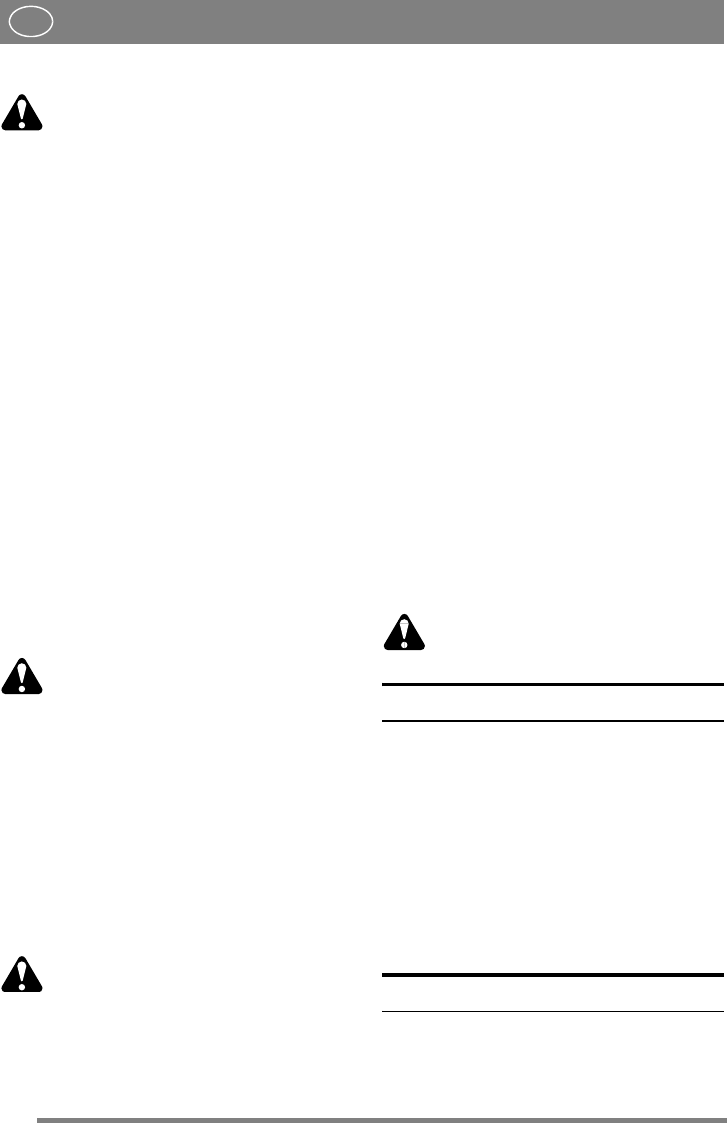
ENGLISH
GB
CHANGING OIL
Change the oil when the engine is warm
and the petrol tank is empty. Hot oil will
run out of the engine better. Use caution
when draining the hot oil, as it could
cause burn injuries.
Change the oil the first time after 5 hours of
operation, and subsequently after every 50 hours
of operation or once a season. Remove the dip
stick, tilt the mower and let the oil run out into a
container. Be careful not to let any oil run on to the
grass.
Fill with new oil: use oil of SAE 30 or SAE 10W-
30 quality. The crankcase holds approx. 0.6 litre.
Fill until the oil reaches the "FULL/MAX" mark
on the dip stick.
AIR FILTER
A dirty and blocked air filter reduces the engine
output and increases engine wear.
Carefully remove the air cleaner so that no dirt
falls down into the carburettor (fig. 11). Take out
the foam plastic filter element and wash it in liquid
detergent and water. Dry the filter element. Pour a
little oil on the filter element and squeeze it in.
Refit the air cleaner.
Wash the filter every three months or every 25
hours running, whichever comes first, or more
frequently if used in dusty conditions.
SPARKING PLUG
Never remove the spark plug or the
ignition lead when checking to see if there
is any spark, always use an approved test
instrument.
Clean the sparking plug regularly (every 100 hours
running). Use a wire brush for cleaning and adjust
the correct spark gap (fig. 12).
Change the sparking plug if the electrodes are
excessively burnt or if the plug is damaged. The
recommendations of the engine manufacturers are
as follows:
Champion J19LM (RJ19LM) or another
equivalent spark plug ought to be used in Briggs &
Stratton engines. Spark gap 0.7-0.8 mm.
CHANGING BLADES
Use protective gloves to prevent cuts
when changing the blade.
Blunt and damaged blades tear off the grass and
spoil the look of the lawn after mowing. New, well
sharpened blades cut the grass cleanly, so that the
lawn looks green and fresh even after mowing.
Always check the blade after an impact. First
disconnect the ignition cable. If the blade system
has been damaged the defective parts must be
changed. Always use genuine spare parts.
To replace the blade, slacken the blade bolt. Fit the
new blade so that the stamped STIGA logotype is
turned facing the blade attachment (and not facing
the grass). Refit the washer and blade bolt. Tighten
the blade bolt fully to a torque of 40 Nm (fig. 13).
When replacing the blade, the blade bolt should
also be replaced.
The guarantee does not cover damage to the blade,
blade holder or engine caused by running into
obstacles.
When replacing the blade, the blade holder and
blade bolt, always use original spare parts. Non-
authentic spare parts could lead to the risk of
personal injury or damage, even if they fit the
machine.
SHARPENING OF THE BLADE
Sharpening of the blade must be done by wet
method grinding, using a whetstone or a
grindstone.
For the sake of safety, the blade should not be
sharpened on an emery wheel. A very high
temperature could cause the blade to become
brittle.
Once the blade has been sharpened, it
must then be balanced so as to avoid
vibration damage.
STORAGE
WINTER STORAGE
Empty the fuel tank. Start the engine and let it run
until it stops. The same petrol must not remain in
the tank for more than one month.
Tip up the mower and screw out the sparking plug.
Pour a teaspoon of engine oil in the sparking plug
hole. Pull out the starting handle slowly so that the
oil is distributed in the cylinder. Screw in the
sparking plug.
Thoroughly clean the mower and store it indoors in
a dry place.
SERVICING
Genuine spare parts are supplied by service
workshops and by many dealers.
www.stiga.com











